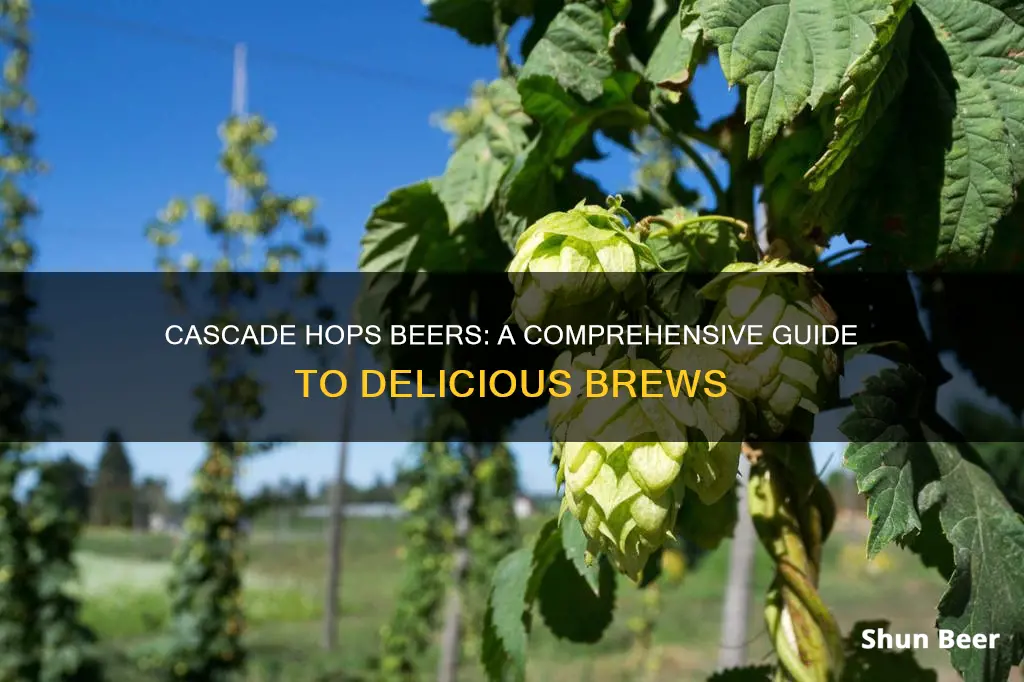
Cascade hops are considered the quintessential American hop, with a unique floral, spice, and citrus flavour, often with strong grapefruit notes. It was the first hop to come out of the USDA hop-breeding program at Oregon State University and was released to the public in 1972. It is a dual-purpose hop, used in all hop additions throughout the brewing process, but is most famous for being the finishing hop in Sierra Nevada's Pale Ale, widely considered the beer that launched the IPA and bitter beer craze. Other notable beers that use Cascade hops include Mirror Pond Pale Ale from Deschutes Brewing Co., Liberty Ale from Anchor Brewing Co., and Harpoon IPA from Harpoon Brewing Co.
What You'll Learn

Cascade hops are used in Sierra Nevada's Pale Ale
Cascade hops are one of the most popular hops in the world, making up a tenth of all hops grown in the US. They were developed in the 1950s and 60s in the USDA breeding program at Oregon State University by Dr Stanley Nelson Brooks and Jack Horner. The variety was first used commercially in 1975 by the Anchor Brewing Company, which established it as a signature hop for American pale ale.
The Sierra Nevada Brewing Company was founded in 1979 in Chico, California, by homebrewing enthusiasts Ken Grossman and Paul Camusi. The pair's inaugural commercial creation was a stout, with the first batch of pale ale coming a few days later, in November 1980. The beer was released the following spring and relied on Cascade hops for its bright, citrusy aroma.
Sierra Nevada's Pale Ale was a bold move in 1980, making a flagship beer with a strong hop character. At the time, there was a "homogenization of beer", with dull flavour being the default. Ken Grossman said:
> "Pale Ale was sort of born out of trying to balance the technology we had at that time as brewers and [making] a product that would leave a lasting impression on the drinker. And we wanted it to have a distinctive hop character."
The distinctive character of Cascade hops, with its piney citrus notes, was an important factor in the creation of the beer. Grossman said:
> "I think as far as style goes, the craft brewers from early on wanted to do something different but also something that really had some flavor impacts. So malts and hops are what you have to work with and the Cascade character being quite a bit different from the noble hop aroma. The Cascade was actually around for a number of years and was spurned by the big brewers as being too distinctive and not noble aroma-ish. Most of the major brewers had German influence and Cascade was an oddball compared to what they were used to with more subtle aromas from Saaz and Hallertau and some of the other varieties. The fear was that they didn’t want to have a lot of pronounced hop character and aroma in their beer and the Cascade had a lot of that, so. It floundered for a number of years [...] It was my familiarity with that hop and the distinctive nature of the aroma—the piney citrus—that I appreciated and enjoyed and wanted to incorporate into our pale ale."
Sierra Nevada's Pale Ale has been influential in the American brewing scene, with brewers drawing inspiration from it and using it as a yardstick to measure their newer creations. It has also helped to revive the American beer industry, making hops famous and sparking a thousand imitators.
Hops in Beer and Vinegar: What's the Connection?
You may want to see also

Cascade is a dual-purpose hop
Cascade hops are widely available and are grown in multiple countries. They are usually packaged as hop pellets but are sometimes available fresh around harvest time. Cascade hops can be grown at home since they are not a trademarked variety.
Cascade hops are defined by their citrus flavour, often with hints of grapefruit. They also have medium-intense floral and spice qualities. When used as a bittering hop, it imparts moderate bitterness.
Cascade is the quintessential American hop. It was the first hop to come out of the USDA hop-breeding program and has become an essential hop addition in many American Pale Ales and most West Coast IPAs. It was developed in the 1950s and released in 1972. It is named after the Cascade Range, mountains that run from northern California to British Columbia, Canada.
Wheat Beer and Hops: An Unlikely Friendship
You may want to see also

Cascade is the quintessential American hop
The Cascade hop was initially bred to maintain healthy crops, as Oregon's previous crops were largely susceptible to disease. The new variety showed promise, as it was resistant to Downy Mildew and similar to the German aroma hops that were so popular with American breweries. The Cascade hop was also a viable alternative to noble hops from Germany, which were affected by Verticillium Wilt, causing import prices to skyrocket.
The Cascade hop was first used commercially by Anchor Brewing Company, which established it as a signature hop for American Pale Ale. It was also prominently featured in Sierra Nevada's Pale Ale, which is widely considered the beer that launched the IPA and bitter beer craze. The hop is known for its trademark citrusy, floral, and grapefruity aroma. It is a dual-purpose hop, used in all hop additions throughout the brewing process, and is most famous for being the finishing hop.
The Cascade hop is widely available and grown in multiple countries, including New Zealand, Australia, and Argentina. It is usually packaged as hop pellets but is sometimes available fresh around harvest time. The hop has become a bigger player in the brewing industry, especially among craft brewers, with dedicated acreage continuing to grow.
Mexican Beer and Hops: A Complex Relationship
You may want to see also

Anchor Brewing Company Liberty IPA uses Cascade hops
The Anchor Brewing Company's Liberty IPA is a beer that uses Cascade hops. This IPA is a reimagining of the classic Liberty Ale, first brewed in 1975 to celebrate the 200th anniversary of Paul Revere's midnight ride. The original Liberty Ale was considered a forerunner of the modern IPA, introducing America to the Cascade hop and reviving the art of dry-hopping.
The Liberty IPA continues to use Cascade hops, combining them with new hop varieties to create a complex aroma of pine and citrus. The beer is made with two-row pale malt and features a label with a bald eagle, a symbol that holds deep meaning for many Americans, including Native Americans.
The Cascade hop itself has an interesting history, having been developed in the 1960s by Dr. Stanley Nelson Brooks and Jack Horner as part of the USDA breeding program at Oregon State University. It was first used commercially in 1975 by the Anchor Brewing Company and became a signature hop for American pale ales. Cascade hops are known for their floral, spicy, and citrus-like qualities, with a slight grapefruit characteristic. They are commonly used in both flavouring and aroma applications.
Today, Cascade hops are grown not only in the Pacific Northwest of the U.S. but also in Australia and New Zealand, with each region imparting unique flavour profiles to the hops. The Anchor Brewing Company's Liberty IPA is a testament to the versatility and popularity of Cascade hops in the craft beer industry.
Hops and Hues: Unveiling the Color Mystery in Beer Brewing
You may want to see also

Cascade hops are available to purchase
Cascade hops were first bred in the 1950s by Jack Horner and his team at Oregon State University and were released to the public in 1972. They are named after the Cascade Range, mountains that run from northern California to British Columbia, Canada. The hops were originally developed through the open pollination of the English variety Fuggle and the Russian variety Serebrianka.
Cascade hops are most famous for being the finishing hop in Sierra Nevada's Pale Ale, widely considered the beer that launched the IPA and bitter beer craze. They are also used in Anchor Brewing's Liberty Ale, the first post-Prohibition IPA and the first single-hopped American ale.
Cascade hops are a dual-purpose hop, most often used as an aroma hop but also on the bittering side of the brew. They are well-suited to just about any ale and lager but are particularly popular in American Pale Ales. They are known for their distinct spicy citrus aroma with hints of grapefruit.
Hop Head Beers: A Guide to Bitter Brews
You may want to see also
Frequently asked questions
Some beers that feature Cascade hops include Sierra Nevada Brewing Co. Pale Ale, Anchor Brewing Company Liberty IPA, Tröegs Independent Brewing Perpetual IPA, and Bear Republic Brewing Co. Racer 5 IPA.
Cascade hops have a flowery and spicy, citrus-like quality with a slight grapefruit characteristic.
Cascade hops were developed in the 1960s by Dr. Stanley Nelson Brooks and Jack Horner as part of the USDA breeding program at Oregon State University. The variety was first used commercially in 1975 by the Anchor Brewing Company and was later made famous by Sierra Nevada's Pale Ale.
Some common substitutions for Cascade hops include Centennial, Amarillo, Columbus, Ahtanum, and Mt. Hood.







